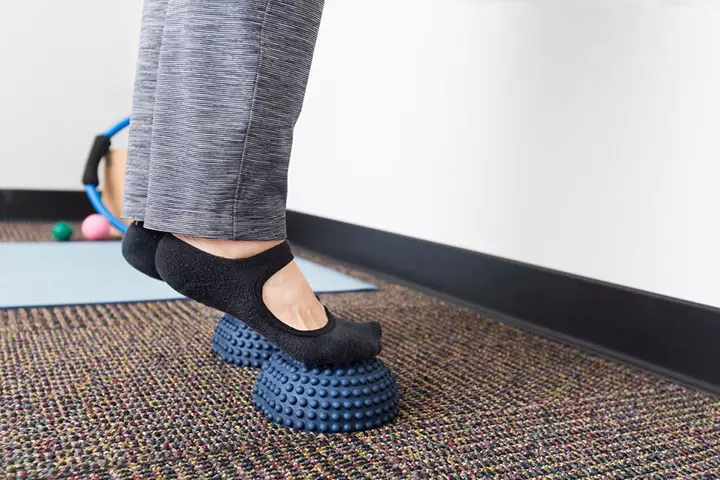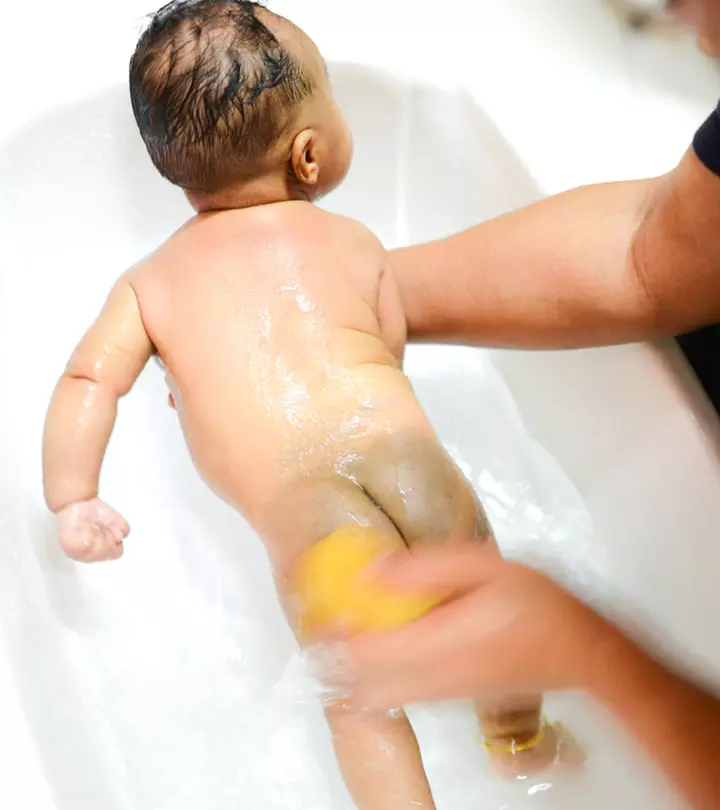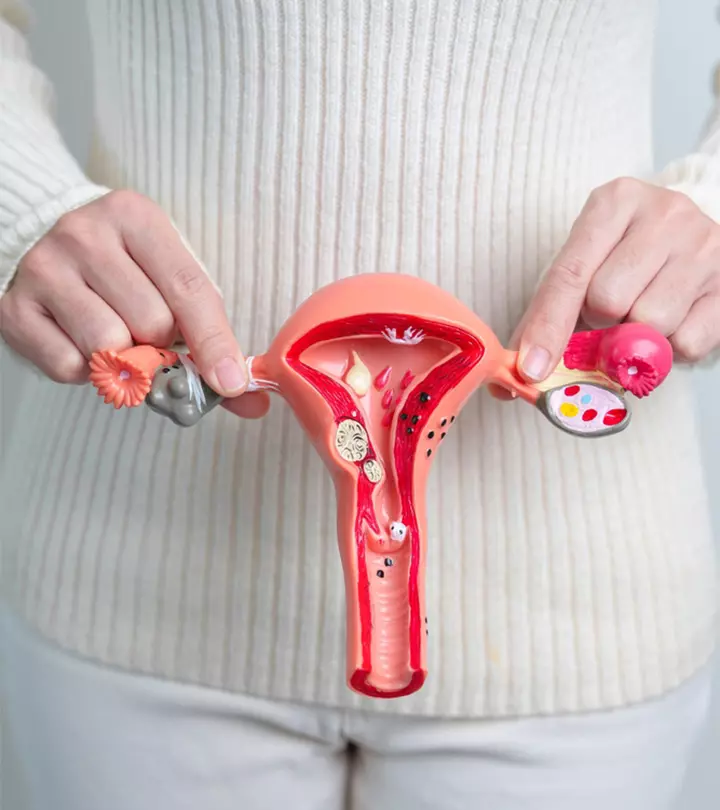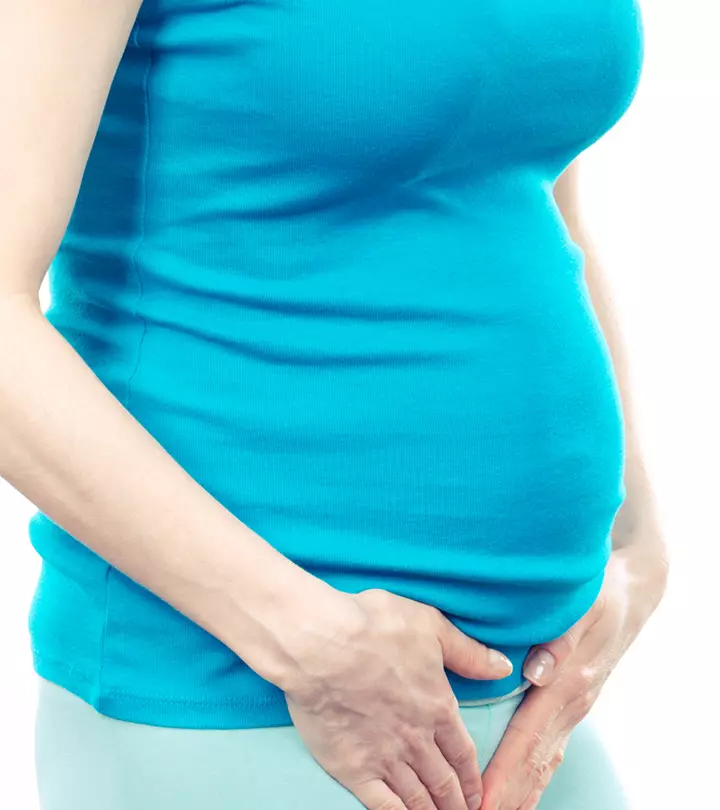
Kegel exercises after delivery are proven to help women strengthen their pelvic floor muscles and lessen postpartum discomfort (1) (2). Therefore, if you are thinking of doing kegel exercises as your routine postpartum exercise, you must first understand the pelvic floor muscles.
The pelvic floor muscles support your uterus and bladder and are positioned around your genital area. In brief, these are the muscles that tighten when you hold back your pee. Therefore, kegel exercises can help improve bladder control, sexual health, and overall pelvic support.
In this post, we’ll explain when you may start practicing kegel exercises after childbirth, their benefits, and also suggest several exercises to try.
Key Pointers
- Kegel exercises are helpful in strengthening the muscles that support the uterus and bladder, as well as the pelvic floor muscles.
- Exercises such as hold and release and heel slides can be started six weeks after delivery.
- Pelvic exercises such as pelvic tilt, mini kegel squats, and pelvic rocks can be done around eight to twelve weeks after delivery.
- However, starting post-delivery pelvic floor exercises with proper guidance from a doctor is recommended.
- To prevent injuries, it’s essential to practice adequate breathing, correct posture, routine exercising, and a gradual increase in repetitions.
The Right Time To Start Kegel Exercises After Delivery
The right time to start kegel exercises depends on the type of delivery (normal or cesarean) you had and how active you were during pregnancy. In the case of uncomplicated normal birth, you may start simple and effortless kegel exercises a few weeks after giving birth. But in the case of normal delivery with episiotomy, you might have to wait for a few weeks.
If you have had a c-section, it takes four to six weeks for the incision to heal, after which you should be able to start the exercises (3) (4). In any case, you should talk to your doctor before starting the exercise as every pregnancy is different.
How Kegel Exercises Can Help After Delivery
Besides strengthening pelvic floor muscles, regular kegel exercises can help in the following ways.
- Urine incontinence: Researchers at Maastricht University discovered that urinary incontinence decreases to 21% at three months postpartum. However, after one year, it surged to 31%. Strengthening the pelvic floor muscles by performing kegel exercises can help prevent urine leakage and enhance bladder control after delivery (5).
- Pelvic floor prolapse: When the pelvic muscles get weak after delivery, they could drop down and push against the walls of the birth canal. But doing kegel exercises regularly after childbirth might help you prevent this (6).
- Postnatal healing: Sometimes, an episiotomy is done on the perineum during labor to facilitate childbirth. Post the procedure, the body needs time and proper care to heal. Postnatal kegel exercises help in reducing perineal pain (7).
Additionally, kegel exercises can help reduce pelvic pain, prevent the risk of pelvic floor disorders, and help increase sexual satisfaction. A study evaluated the occurrence and severity of urine leakage in pregnant women. The graph below shows that women who performed pelvic floor exercises during pregnancy reported pregnancy incontinence less often than women who did not.

Impact of pelvic floor exercises on the incidence and severity of UI in pregnancy
Source: The Impact of Pelvic Floor Exercises on the Quality of Life of Women with Urinary Incontinence – Analysis of Pregnancy and the Postpartum Period; Journal of Novel Physiotherapy and Physical Rehabilitation Quick tip
Quick tipNext, we give you a list of kegel exercises you can try during the weeks after childbirth.
11 Postpartum Kegel Exercises You May Try After Childbirth
Before you start these kegel exercises, talk to your doctor about them, and find out if it is okay for you to do them.
After six weeks
Here are a few simple kegels you can try in or around the sixth week after delivery.
1. Hold and release
You may try this simple and basic exercise thrice a day (5).

How to:
- You can sit on the floor or a chair
- Breathe in and breathe out throughout the exercise
- To hold or squeeze the pelvic floor muscles, pretend that you are to hold the urine
- Hold for a few seconds or count to three
- Then release slowly and count to three
- Repeat the same about ten to 15 times
- Repeat the sets three times a day
2. Standing kegel activation
This is a variation of the first exercise and involves breathing and contractions.

How to:
- Stand straight, and do not bend
- Inhale and exhale to start the exercise
- Hold the pelvic floor muscles for a few seconds, while breathing normally
- Release the contraction for a few seconds
- Breathing and contractions should be in sync
- Repeat it for about ten times
- Repeat the sets three times a day
3. Heel slides
This exercise can be used to restore functional strength (8).

How to:
- Lie down on the floor with your knees bent
- Start with slow breathing exercises
- Slide the right leg out, parallel to the ground and then bring it back to the starting position
- Repeat the same with your left leg
- Start with five sets and gradually increase it to ten a day
4. Slow and quick contractions
These simple exercises help strengthen your pelvic floor muscles. You may do them anytime, either while reading or watching TV (9).

How to:
Slow contractions
- Hold your pelvic floor contraction for about ten sections
- And then release slowly for ten sections
- You can do it for less than ten seconds too if that is what is comfortable to start with
- Practice it regularly and gradually build up to holding the contractions for ten seconds
Fast contractions
- Hold the contraction for one second, and release and relax the next
- Initially, doing it one or two times is good enough
- You may gradually increase it to ten times
After eight weeks
5. Pelvic tilt
This exercise helps in strengthening and toning the abdominal muscles and also alleviates backache (1).

How to:
- Lie down on your back and bend your knees
- Tighten the buttock and abdominal muscles for tilting the pelvis. Make sure you are not arching your back
- Hold to the count of three, and slowly bring it down
- Repeat this five times a day
6. Pelvic bridge
It is good for both strengthening the pelvic and abdominal muscles (10) (11). You may ask your doctor about this exercise and the right time to do it post-delivery. In case you find it difficult or feel uncomfortable during or after the exercise, do not continue.

How to:
- Lie down on the back and bend your knees
- Slowly lift your tummy or push the pelvis up, keeping your hands on the sides
- Hold the position for five to ten seconds (hip muscles and glutes should be tightened)
- And come down in the starting position while relaxing the muscles
- Relax for a while and repeat the routine six to eight times. Once it gets easy and you get comfortable with it, increase the number of repetitions
7. Pelvic leg fall out
This exercise is also called a bent knee fall out, or single-leg fall out. It is good for the abdomen and the groin (12).

How to:
- Lie down on the back and fold your knees
- Breathe in and breathe out
- When breathing out, hold the pelvic floor muscles and let your right leg fall to the side
- Release the contraction and bring the leg back to the start position
- Repeat the same with left leg
- Do the exercise for about ten times
After 12 weeks
Now that you are used to the above pelvic or kegel exercises, you can increase the number of sets for each. Or, you can try some advanced pelvic exercises, but after checking with the doctor first.
8. Pelvic rocks
This exercise is a great way to improve your pelvic and back muscle tone.

How to:
- Come down on all your fours (hands and knees)
- Inhale and tuck your head downwards. Push your back up to form a curve and hold it there for a few seconds
- Exhale and look upwards while lowering the back, and hold the position for a few seconds
- Repeat the same for five to eight times
9. Mini kegel squats
Three months after the delivery, your body is ready to perform other workouts too. Squatting and mini squats holding your baby are among the recommended exercises with a baby to help your back, pelvic floor muscles, and even abdomen area (13).

How to:
- Once you are comfortable with sitting, standing, and focusing on the right posture, you may start the mini squats
- Stand on the ground with your feet wide apart
- Gently lower down by pushing your hips
- Your knee should be in alignment with your feet, and your shoulders should be straight
- Once you are comfortable with mini squats, you can try squats and deep squats
10. Kegel heel raises
This exercise strengthens the lower part of your body and helps you balance better.

How to:
- Stand on the floor, keep your back and shoulders straight
- Breathing in and out should be constant
- Slowly lift your heels; you can put your hands up or take the support of a wall or chair if needed
- Hold for a few seconds and come to the start position
- Kegel contractions should be done throughout the exercise
- You can start with four or five, and then increase the repetitions as you get comfortable.
 Point to consider
Point to consider11. Plank
Some people recommend doing the plank exercise postpartum. However, a few also suggest avoiding them. There is no proper evidence to support the claims. You may ask your healthcare professional to advise you based on your condition post-delivery.

How to:
- Lie down face forward on the floor, but with only your toes and elbows touching the floor
- Your back should be stiff and straight
- Hold the posture to a count of eight or ten, and release
- Repeat it two or three times
Regular kegel exercises can be beneficial for your overall pelvic health, and also give you a chance to get back to your pre-pregnancy shape. However, if you feel any discomfort, pain, or other unusual symptoms while performing Kegel exercises, stop the exercise and consult the doctor immediately.
Tips For Doing Kegel Exercises
It is easy to do kegel exercises after delivery, provided you do them right. Start slow and remember these tips to get it right.
- To get started, identify your pelvic floor muscles by pretending to hold your urine.
- Be focused, don’t hold or bend the muscles in the buttocks, thighs, or abdomen.
- Keep inhaling and exhaling while performing kegel exercises and ensure that you do not hold the breath.
- Initially, you may start with one or two kegel exercises and do it twice or thrice a day. And once you get comfortable, you may try different kegels and also increase the number of repetitions.
- Whether you are sitting, standing, or lying down during the pelvic floor exercises, your posture has to be straight.
- Make these exercises a part of your routine for long-term benefits and rehabilitation.
 Did you know?
Did you know?Frequently Asked Questions
1. Is it common to have pelvic floor issues after birth?
Pregnancy and childbirth put tremendous strain on pelvic floor muscles that may cause a weakened pelvic floor in several women. Urinary leakage, abdominal muscles separation (diastasis recti), low back pain, and pelvic organ prolapse are some of the common pelvic floor issues new moms could experience after delivery (14).
2. How long does it take to strengthen the pelvic floor after birth?
Every pregnancy and childbirth experience is different. Hence, every mother’s time to strengthen pelvic floor muscles after childbirth may vary. Generally, it takes four to six weeks for individuals to notice some improvement. However, it may take as long as three months or more to see significant changes in the pelvic floor strength (15).
3. Can kegel exercises improve sexual function after delivery?
Research indicates that pelvic muscle exercises, such as kegel exercises, could enhance sexual self-efficacy after delivery. Therefore, consult your gynecologist to devise a specific plan and incorporate these exercises into your workout regime (17).
4. Are there any risks associated with doing kegel exercises after delivery?
Although these exercises benefit women, they must be performed while taking certain simple precautions. For example, women must refrain from doing Kegel exercises while urinating or applying excessive pressure when performing the exercise, as it could cause negative consequences for the kidneys and vaginal muscles (18).
Infographic: Kegel Exercises To Try After Childbirth
Kegel exercises are a great way to strengthen your pelvic floor after childbirth. Incorporating Kegels into your daily routine can contribute significantly to your postpartum recovery. Here’s an infographic featuring some of the most beneficial Kegel exercises for mothers post-delivery. Save it for future reference and share it with fellow mothers who may find it helpful.

Illustration: Momjunction Design Team
Kegel exercises are simple and do not require any equipment, allowing you to work out in the privacy of your home. To tone and strengthen your pelvic floor muscles and promote postnatal healing, you have to take a few minutes of your day and learn Kegel exercises after delivery. You can try standing Kegel activation, heel slides, pelvic tilt, pelvic bridge, pelvic rock, and other postnatal exercises. Confer your doctor if you have any concerns about a kegel exercise, and stop doing it if you feel any discomfort or pain.
Illustration: Safe Kegel (Pelvic Floor) Exercises After Delivery (With Pictures)
_exercises_after_delivery_(with_pictures)_illustration.jpg.webp)
Image: Stable Diffusion/MomJunction Design Team
Learn how to do postpartum kegels exercises for beginners with this easy to follow routine. Strengthen your pelvic floor muscles and get back in shape after childbirth.
References
1. Five exercises to strengthen your pelvic floor; UT Health San Antonio
2. Kegel exercise; Allina Health (2002)
3. Safe return to exercise after pregnancy; Pregnancy Baby & Birth.
4. C-Section Recovery Timeline and Aftercare; Cleveland Clinic
5. Kegel exercises; Beth Israel Lahey Health Winchester Hospital
6. The pelvic floor; the women’s
7. R. E. Farrag, A. S. Eswi, and H. Badran; Effect Of Postnatal Exercises on Episiotomy Pain and Wound Healing Among Primiparous Women; IOSR Journal of Nursing and Health Science (2016)
8. N. Nichols; Restore Your Core: Progressive Exercises for Post-Pregnancy; American Fitness
9. Pelvic floor muscle exercises; Great Ormond Street Hospital for Children
10. Epilepsy Basics; The Centers for Disease Control and Prevention
11. A. Cabotaje; What You Should Know About Exercising After Having a Baby; UW Medicine (2019)
12. Postpartum Fitness Getting Back In Shape After Your Pregnancy; Kaiser Permanente
13. Body after birth: Treating post-pregnancy problems; UT Southwestern MedicalCenter (2016)
14. PREPARTUM & POSTPARTUM PELVIC FLOOR COMPLICATIONS; University Of Utah (2016)
15. Pelvic floor muscle training exercises; MedlinePlus
16. Pelvic floor exercises.
17. Golmakani et al.; The effect of pelvic floor muscle exercises program on sexual self-efficacy in primiparous women after delivery; NCBI (2015)
18. Kegel exercises – self-care; National Library of Medicine.
Community Experiences
Join the conversation and become a part of our nurturing community! Share your stories, experiences, and insights to connect with fellow parents.
Read full bio of Dr Ankita Gharge
Read full bio of shreeja pillai
Read full bio of Rebecca Malachi
Read full bio of Aneesha Amonz





















